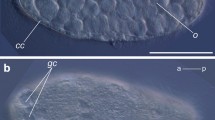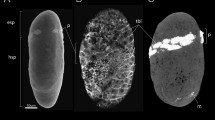Abstract
Syllids are one of the most speciose annelid taxa and characterized by their variety of reproductive modes. We provide the description of a new species of Syllidae (Annelida, Phyllodocida), Typosyllis antoni n. sp., which is characterized by its distinct color pattern consisting of transversal red lines on the dorsum of anterior segments; long antennae and dorsal cirri with strong alternation in length; bidentate chaetae falciger like with long spinulation on edge, one tiny and thin acicula appearing in posterior segments in addition to thicker and pointed one, and a long proventricle. A phylogenetic analysis of Syllinae based on three genes supports that T. antoni n. sp. is sister species to Typosyllis heronislandensis. This sister group relationship may indicate a common ancestor from the Pacific. Moreover, we recommend several steps to unify the taxonomy with phylogenetic knowledge of this group. Using immunocytochemistry coupled with confocal laser scanning microscopy (cLSM), we describe the internal morphology of this species. The body wall is composed of two dorsal and two ventral longitudinal muscle bundles that form a distinct inner layer. The outer or “circular layer” of body wall musculature is represented by prominent transverse muscle fibers that exhibit a semicircular arrangement. The musculature of the uniramous parapodia is characterized by distinct parapodial retractor muscles, acicular protractor muscles, as well as prominent acicular and chaetal flexor muscle bundles. T. antoni n. sp. reproduces by schizogamic scissiparity producing dicerous stolons. This species is able to regenerate the anterior end, including the prostomium, the first chaetae-less segment with all appendages, and some additional chaetigers, depending on the dissection side. Regeneration of the proventricle, ventricle, caeca, or pharyngeal tooth is not detectable. In contrast, regeneration of the posterior end appears to be complete. The available data makes T. antoni n. sp. to be one of the best investigated syllids, emphasizing its potential as model for the whole group. Our analysis establishes a framework for future studies on the evolution of reproductive modes in Syllidae, and we outline research questions how they are related to regeneration and development.










Similar content being viewed by others
References
Aguado, M. T., & San Martín, G. (2006). Sílidos intersticiales (Syllidae: Polychaeta) del Parque Nacional de Coiba (Pacífico, Panamá). Revista de Biología Tropical, 54(3), 725–743.
Aguado, M. T., & San Martín, G. (2009). Phylogeny of the Syllidae (Polychaeta) based on morphological data. Zoologica Scripta, 38, 379–402.
Aguado, M.T; San Martín, G., & Nishi, E. (2006). Two new species of Syllidae (Annelida: Polychaeta) from Japan. Scientia Marina, 70S3, 9–16.
Aguado, M. T., Nygren, A., & Siddall, M. E. (2007). Phylogeny of Syllidae (Polychaeta) based on combined molecular analysis of nuclear and mitochondrial genes. Cladistics, 23, 552–564.
Aguado, M. T., San Martín, G., & Ten Hove, H. (2008). Syllidae (Annelida: Polychaeta) from Indonesia collected in the Siboga (1899–1900) and Snellius II (1984) expeditions. Zootaxa, 1673, 1–48.
Aguado, M. T., San Martín, G., & Siddall, M. (2012). Systematics and Evolution of syllids (Annelida, Syllidae). Cladistics, 28, 234–250.
Allen, E. J. (1923). Regeneration and reproduction of the syllid Procerastea. Philosophical Transactions of the Royal Society, London, B., 211, 131–177.
del Castillo, J., Anderson, M., & Smith, D. S. (1972). Proventriculus of a marine annelid: muscle preparation with the longest recoded sarcomere. Proceedings of the National Academy of Sciences, USA, 69(7), 1669–1672.
Farris, J., Abert, V., Källersjö, M., Lipscomb, D., & Kluge, A. (1996). Parsimony jackknifing outperforms neighbor-joining. Cladistics, 12, 99–124.
Fauchald, K., & Jumars, P. A. (1979). The diet of worms: a study of polychaete feeding guilds. Oceanography and Marine Biology, 17, 193–284.
Filippova, A., Purschke, G., Tzetlin, A. B., & Müller, M. C. M. (2010). Musculature in polychaetes: comparison of Myrianida prolifera (Syllidae) and Sphaerodoropsis sp. (Sphaerodoridae). Invertebrates Biology, 129, 184–198.
Fischer, A., & Dorresteijn, A. (2004). The polychaete Platynereis dumerilii (Annelida): a laboratory animal with spiralian cleavage, lifelong segment proliferation and a mixed benthic/pelagic life cycle. BioEssays, 26, 314–325.
Fischer, A., & Fischer, U. (1995). On the life-style and life-cycle of the luminescent polychaete Odontosyllis enopla (Annelida: Polychaeta). Invertebrate Biology, 114, 236–247.
Franke, H. D. (1983). Endocrine mechanisms mediating light-temperature effects on male reproductive activity in Typosyllis prolifera (Polychaeta, Syllidae). Wilhelm Roux’s Archives of Developmental Biology, 192, 95–102.
Franke, H. D. (1986). The role of light and endogenous factors in the timing of the reproductive cycle of Typosyllis prolifera and some other polychaetes. American Zoologist, 26, 433–445.
Franke, H. D. (1999). Reproduction of the Syllidae. Hydrobiologia, 402, 39–55.
Glasby, C. J. (2000). Family Syllidae (In Beesley, P.L., Ross, G.J.B., & Glasby, C.J. (Eds.), Polychaetes and allies: The Southern Synthesis. Fauna of Australia. Vol. 4 Polychaeta, Myzostomida, Pogonophora, Echiura, Sipuncula (pp. 161–167)). Melbourne: CSIRO Publishing.
Glasby, C. J., Schroeder, P. C., & Aguado, M. T. (2012). Branching out: a remarkable new branching syllid (Annelida) living in a Petrosia sponge (Porifera: Demospongiae). Zoological Journal of the Linnean Society, 164, 481–497.
Goloboff, P. A., Farris, J. S., & Nixon, K. (2008). TNT: a free program for Phylogenetic analysis. Cladistics, 24, 774–786.
Hartmann-Schröder, G. (1979). Teil 2. Die Polychaeten der tropischen Nordwestküste Australiens (zwischen Port Samson in Norden und Port Hedland in Süden). Zur Kenntnis des Eulitorals der australischen Küsten, unter besonderer Berücksichtigung der Polychaeten und Ostracoden. Mitteilungen aus dem hamburgischen zoologischen Museum und Institut, 76, 75–218.
Hartmann-Schröder, G. (1981). Teil 6. Die Polychaeten der tropisch-subtropischen Westküste Australiens (zwischen Exmouth im Norden und Cervantes im Süden). Mitteilungen aus dem hamburgischen zoologischen Museum und Institut, 78, 19–96.
Hartmann-Schröder, G. (1989). Teil 14. Die Polychaeten der antiborealen und subtropisch-tropischen Küste Südost-Australiens zwischen Lakes Entrance (Victoria) im Süden und Maclean (New South Wales) im Norden. Mitteilungen aus dem hamburgischen zoologischen Museum und Institut, 86, 11–63.
Hartmann-Schröder, G. (1991). Teil 16. Die Polychaeten der subtropisch-tropischen bis tropischen Ostküste Australiens zwischen Maclean (New South Wales) und Gladstone (Queensland) sowie von Heron Island (Grosses Barriere-Riff). Mitteilungen aus dem hamburgischen zoologischen Museum und Institut, 88, 17–71.
Haswell, W. A. (1920). Australian Syllidae, Eusyllidae and Autolytidae. Journal of the Linnean Society of London, 24, 90–112.
Heacox, A. E., & Schroeder, P. (1982). The effects of prostomium and proventriculus removal on sex determination and gametogenesis in Typosyllis pulchra (Polychaeta: Syllidae). Wilhelm Roux's Archives of Developmental Biology, 191, 84–90.
Helm, C., Weigert, A., Mayer, G., & Bleidorn, C. (2013). Myoanatomy of Myzostoma cirriferum (Annelida, Myzostomida): implications for the evolution of the myzostomid body plan. Journal of Morphology, 274, 456–466.
Jeuniaux, C. (1969). Nutrition and digestion. In M. Florkin & B. T. Scheer (Eds.), Chemical Zoology (Annelida, Echiura, and Sipuncula, Vol. IV, pp. 69–91). New York: Academic.
Katoh, K., Misawa, K., Kuma, K., & Miyata, T. (2002). MAFFT: a novel method for rapid multiple sequence alignment based on fast Fourier transform. Nucleic Acids Research, 30, 3059–3066.
Lamarck, J. B. P. A. D. (1818). Histoire Naturelle des animaux sans vertèbres, présentant les caractères generaux et particuliers de ces animaux, leur distribution, leur classes, leur familles, leur genres, et la citation synonymique des principales espèces qui s´y rapportent; précedés d′une introduction offrant la détermination des caractères essentiels de l′Animal, sa distinction du végétal et des autres corps naturelles, enfin l′Exposition des Principes fondamentaux de la Zoologie (Vol. 5). Paris: Deterville. 612pp.
Langerhans, P. (1879). Die Würmfauna van Madeira. Zeitschrift für Wissenschaftliche Zoologie, 33, 513–592.
Licher, F. (1999). Revision der Gattung Typosyllis Langerhans, 1879 (Polychaeta: Syllidae). Morphologie, taxonomie und phylogenie. Abhandlungen der Senckenbergischen Naturforschenden Gesellschaft, 551, 1–336.
Nygren, A. (1999). Phylogeny and reproduction in Syllidae (Polychaeta). Zoological Journal of the Linnean Society, 126, 365–386.
Martin, D., Temir, A. B., San Martín, G., & Gil, J. (2003). Inter-population variability and character description in the sponge-associated Haplosyllis spongicola complex (Polychaeta: Syllidae). Hydrobiologia, 496, 145–162.
Okada, Y. K. (1929). Regeneration and fragmentation in the syllidian polychaetes. Wilhelm Roux′ Archiv für Entwicklungsmechanik der Organismen, 115, 542–600.
Okada, Y. K. (1938). An internal factor controlling posterior regeneration in syllid polychaetes. Journal of the Marine Biological Association of the United Kingdom, 23, 75–78.
Pleijel, F. (2001). Syllidae, Grube, 1850 (In Rouse, G.W., & Pleijel, F. (Eds.), Polychaetes (pp. 102–105)). New York: Oxford University Press.
Purschke, G., & Müller, M. C. M. (2006). Evolution of body wall musculature. Integrative and Comparative Biology, 46, 497–507.
San Martín, G. (1984). Estudio biogegráfico, faunístico y sistemático de los Poliquetos de la familia Sílidos (Syllidae: Polychaeta) en Baleares. Ediciones de la Universidad Complutense de Madrid, 187, 529.
San Martín, G. (2003). Annelida, Polychaeta II: Syllidae. In Ramos, M.A. et al. (Eds.), Fauna Ibérica, vol. 21. Museo Nacional de Ciencias Naturales. CSIC. Madrid, 554pp.
Simakov, O., Larsson, T. A., & Arendt, D. (2013). Linking micro- and macro-evolution at the cell type level: a view from the lophotrochozoan Platynereis dumerilii. Briefings in Functional Genomics, 12, 430–439.
Stamatakis, A. (2006). RAxML-VI-HPC: maximum likelihood-based phylogenetic analyses with thousands of taxa and mixed models. Bioinformatics, 22, 2688–2690.
Stamatakis, A., Hoover, P., & Rougemont, J. (2008). A rapid bootstrap algorithm for the RAxML Web servers. Systematic Biology, 57, 758–771.
Storch, V. (1968). Zur vergleichenden Anatomie der segmentalen Muskelsysteme und zur Verwandtschaft der Polychaeten-Familien. Zeitschrift für Morphologie der Tiere, 63, 251–342.
Tzetlin, A. B., & Filippova, A. V. (2005). Muscular system in polychaetes (Annelida). Hydrobiologia, 535(536), 113–126.
Viguier, C. (1902). Sur la valeur morphologique de la tête des Annélides. Annales Des Sciences Naturelles (Zoologie), 25, 281–293.
Weigert, A., Helm, C., Meyer, M., Nickel, B., Arendt, D., Hausdorf, B., Santos, S. R., Halanych, K. M., Purschke, G., Bleidorn, C., & Struck, T. H. (2014). Illuminating the base of the annelid tree using transcriptomics. Molecular Biology and Evolution, 31, 1391–1401.
Westheide, W. (1974). Interstitielle Fauna von Galapagos. XI. Pisionidae, Pilargidae, Syllidae. Mikrofauna Meeresbodens, 44, 195–338.
Wissocq, J. C. (1966). La sexualisation du stolon chez Syllis spongicola Grübe. Cahiers de Biologie Marine, 7, 337–342.
Zantke, J., Bannister, S., Rajan, V. B. V., Raible, F., & Tessmar-Raible, K. (2014). Genetic and genomic tools for the marine annelid Platynereis dumerilii. Genetics, 197, 19–31.
Acknowledgments
We are very grateful to Pat Hutchings, Anna Murray, and Stephen Keable (AM) for the kind loan of specimens; Angelika Brandt, Kathrin Philipps, and Petra Wagner (ZMH) for the loan of T. heronislandensis paratypes; Javier Sánchez (MNCN) for providing us with catalogue numbers for Typosyllis antoni n. sp.; Alberto García (MNCN) for his help with SEM process; and Maher Fahim (UAM) for his help with pictures at the light microscopy. We are very grateful to Miguel Angel Alonso Zarazaga (MNCN) for sharing his expertise, fruitful discussions, and all his kind help investigating into the nomenclature conflicts around the genera Syllis and Typosyllis. This study has been partly supported by a Geddes visiting fellowship to MTA for a research stay at the Australian Museum. CH and MW were supported by special funds of the University of Leipzig. CB received funding from the DFG (BL787/5-1).
Author information
Authors and Affiliations
Corresponding author
Rights and permissions
About this article
Cite this article
Aguado, M.T., Helm, C., Weidhase, M. et al. Description of a new syllid species as a model for evolutionary research of reproduction and regeneration in annelids. Org Divers Evol 15, 1–21 (2015). https://doi.org/10.1007/s13127-014-0183-5
Received:
Accepted:
Published:
Issue Date:
DOI: https://doi.org/10.1007/s13127-014-0183-5




